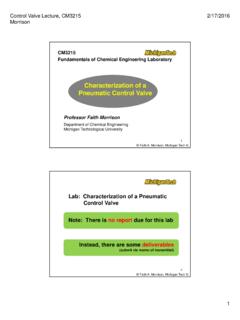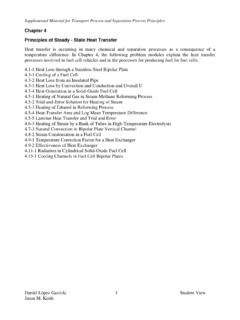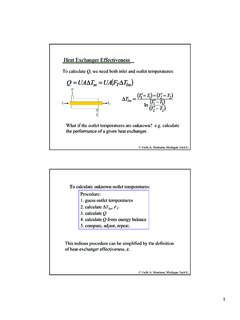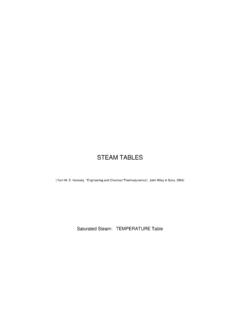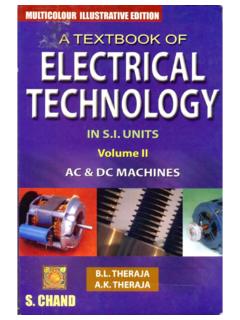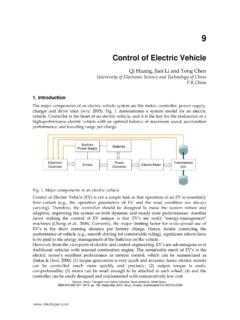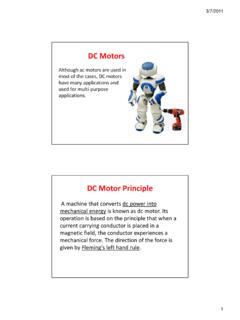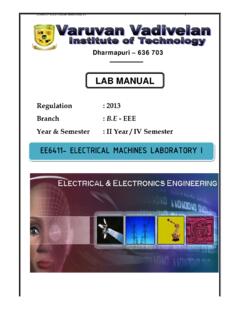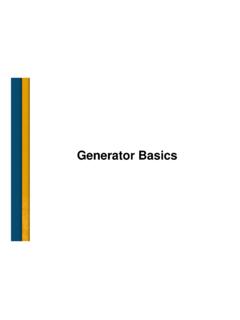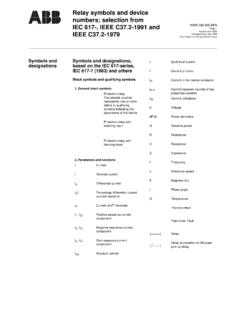Transcription of CHAPTER 11
1 CHAPTER 11DC MachinesIntroductionAlthough DC is not widely used by consumers, DC machines have played a major role in industryover the : elevators use DC machines. DC MACHINE:DC machine operates as the result of the interaction of rotating coils with a stationary magneticfield. The rotorcontains the armature winding -a number of coils mounted in lots on the rotor. The ends of the coils are connected to the commutatorat the end of the rotor. Carbon brushesride on the surface of the commutator to make electrical contact from outside the motor to the armature coils. The stationary magnetic field is provided either by DC coils on the statorof the machine or by permanent magnets mounted inside the stator. 2 The StatorDC machine stator. a)Cross section. b)Side is simpler and less expensive to make a stator using assembled stack of stamped laminations. The ear-shaped projections in the center are the pole faces, which actually become a north and south pole during operation of the machine.
2 The field coils are mounted behind the ear-shaped projections and provide the magnetomotive force (MMF) required to establish the magnetic field. MMF is the product of current and the number of turns in the coil. Thus, MMF can be provided with high current and few turns or with low current and many turns. 3In the DC machine, there are two types of field windings that are commonly used: 1)Shunt field: -Field windings are connected in parallel with the armature to the source voltage or -Field windings are connected to a separate voltage keep the losses of the machine low and to reduce the power requirements for the source, shunt-field coils are constructed of a large number of turns of smaller-gauge )Series-fieldField winding are connected in series with the windings are constructed of a few turns of heavy-gauge wire and placed in series with the types of field coils and the manner in which they are connected has a significant impact on the performance of the machine.
3 4 The RotorThe rotor contains the armature winding , which is the high-power winding of the DC slotsin the lamination provide space for the armature coil. When operating as a generator, the armature winding is rotated through the field, generating a DC voltage that is delivered to the load. For motor operation, the armature winding draws current from the source, and the current in the armature coils interacts with the field to create an electromagnetic torque that drives a mechanical commutatorconsists of a number of copper segments that are electrically insulated from each other and from the rotor brushes are held by springs against the rotating of the commutator so as to make electrical contact and to provide a connection from the rotating coils to the outside world. Details of a DC machine armature . a. Side view of rotor. b. Cross section of commutator. c. Cross section of lamination armature windings carry AC current, whichis rectified by the switching action of the of DC MachinesOne big advantage of DC machines is the variety of ways that the field excitation can be provided a wide range of operating characteristicsThere are two types of field windings: seriesand shunt.
4 A DC machine may have either or both; therefore there are several possible types of DC :A1-A2: the armature terminalsF1-F2: the shunt fieldS1-S2: the series field Shunt-field windingsSeparately excited(use separate DCpower supply)Self-excited(operating machineprovides its own excitation)6 Separately excited DC separately excited field is provided with a separate DC it requires a separate DC power supply, the separately excited machine is usually used only when a wide range of voltage control (generator) or speed control (motor) is field current is typically only a few percent of the rated output current, so a small field current controls a much larger armature current. The separately excited DC generator effectively operates as a power :A1-A2: the armature terminalsF1-F2: the shunt fieldS1-S2: the series field 7 Notation:A1-A2: the armature terminalsF1-F2: the shunt fieldS1-S2: the series field Self-excited means they rely on the generator s own voltage to provide the excitation (note: residual magnetism to provide initial flux is required to build up the initial excitation).
5 Shunt-motor or self-excited generator The shunt connectionis in which the field is connected in parallel, or shunt with the voltage from the armature is applied directly to the field in the case of a generator, while for motoroperation the source voltage is applied to the field and rheostatis used for changing the field currentwithout changing the voltage, and therefore provides a measure of voltage control for the generatorand speed control for the series machine Notation:A1-A2: the armature terminalsF1-F2: the shunt fieldS1-S2: the series field In the series-connectedgeneratorthe field flux is obtained by passing the armature current through the series-field winding . Because the excitation is provided by the armature current, it varies widely with load, especially for a generator and therefore suffers from very poor voltage the series machineis connected as a motor, the field terminals S1 and S2 have to be reversed, because the current would be going into the machine instead of out of it.
6 9 When both series and shunt fields are used on a DC machine, it is called a compound machine. The long-shunt connection: the shunt winding is located directly across the terminals of the machine, and the serieswinding is connected between the shunt and the armature . The short-shunt connection: the shunt winding is directly in parallel with the armature , and the series winding is between the shunt winding and the terminals of the machine. Compound machinesNotation:A1-A2: the armature terminalsF1-F2: the shunt fieldS1-S2: the series field 10 The short or the long shunt can be connected so that the two fields reinforce each other -cumulative compounding or so that they are in opposition to each other -differential compounding. For the cumulatively compounded machine, the series winding provides additional flux as the load current increases. For the generator operation, the current would be from the armature to the terminals so the windings produce flux in the same direction when current the motor operation, they would be differentially compounded because the current would be into the motor, and the two fields would be in opposition.
7 Compound machinesNotation:A1-A2: the armature terminalsF1-F2: the shunt fieldS1-S2: the series field 11DC GeneratorsWhen operated as a generator, the armature of the DC machine is driven by a prime mover. When the armature coils move through the flux created by the stator field, a voltage is induced in them. The voltage in a coil is a function of the velocity of the coil through the flux, the length of the coil, and the flux armature circuit resistance includes the armature winding resistance plus the resistance of the interpolesand compensating windings: The interpoleis a small, narrow winding , mounted on the back iron of the stator in the neutral zone between the poles to speed up commutation in the generator. The compensating windingmounted on the back iron of the stator and consist of a single heavy turn carrying the armature current in the opposite direction that it is carried in the armature coils in order to cancel the armature reaction.
8 Compensating windings are generally very expensive and are used only in large machines. Complete equivalent circuit of a separately excited DC Voltage Equation for a DC Generator:Faraday s law tell us where N is the # of series each revolution, a conductor cuts the flux of P poles, where P is the number of poles in the machine. The total amount of flux cut in one revolution:If the speed of the machine in RPM is represented by n, then the time to complete one revolution is:the flux per poleTo understand the operation of the DC generator we need to obtain the relationshipfor the generated voltage in terms of flux, the physical design of the machine, and its total number of armature conductorsThe number of parallel pathsNumber of series conductorsexpression for the generated voltage of a DC generator: Kg is called the generator constant for a DC machine and is a function of the design of the machine-specifically, the number of poles and the type of winding .
9 14We need to find the number of series conductors in the armature to calculate the generated voltage Depends on the armature winding structureArmature WindingsLap winding :The ends of each coil are connected to adjacent commutator a lap wound armature the number of parallel pathsthrough the armature is equal to the number of poles. Wave winding :The armature coils are connected to commutator segments of commutator on opposite sides of the wave winding has only 2 parallel paths between brushes regardless of the number of poles in the windingprovides more parallel paths, which means higher current and lower wave windinghas more series coils, yielding higher voltage and lower of both hysteresis and saturation effects in the iron of the machine, the flux per pole is a nonlinear function of the field voltage of a DC machine is a linear function of the flux per pole, so it is also nonlinear with respect to the field current.
10 N1 < n2 < n3So if we have two voltages at two different speeds, with the flux per pole held constant: If we know generated voltage at one speed we can calculate generated voltage using the same DC generator at any other speed using:Generated voltage of a DC machine is linear with respect to the rotational speed of the machineMagnetization Curve of the Separately Excited Machine16 Voltage Regulation1. If the field voltageis kept constantthe field current and the flux per pole will also be constant. 2. If the generator is driven at constant speed, the internal voltage, Ea, will be constant .Under conditions (1 and 2), terminal voltage equation represents a linear relationship between the terminal voltage and the armature current, with a negative slope. As the armature load current increases, the terminal voltage will decrease the separately excited generator, the terminal voltage is above rated voltage at less than full load.
